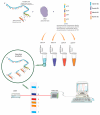The Genetic Diagnosis of Neurodegenerative Diseases and Therapeutic Perspectives
- PMID: 30551598
- PMCID: PMC6316116
- DOI: 10.3390/brainsci8120222
The Genetic Diagnosis of Neurodegenerative Diseases and Therapeutic Perspectives
Abstract
Genetics has led to a new focus regarding approaches to the most prevalent diseases today. Ascertaining the molecular secrets of neurodegenerative diseases will lead to developing drugs that will change natural history, thereby affecting the quality of life and mortality of patients. The sequencing of candidate genes in patients suffering neurodegenerative pathologies is faster, more accurate, and has a lower cost, thereby enabling algorithms to be proposed regarding the risk of neurodegeneration onset in healthy persons including the year of onset and neurodegeneration severity. Next generation sequencing has resulted in an explosion of articles regarding the diagnosis of neurodegenerative diseases involving exome sequencing or sequencing a whole gene for correlating phenotypical expression with genetic mutations in proteins having key functions. Many of them occur in neuronal glia, which can trigger a proinflammatory effect leading to defective proteins causing sporadic or familial mutations. This article reviews the genetic diagnosis techniques and the importance of bioinformatics in interpreting results from neurodegenerative diseases. Risk scores must be established in the near future regarding diseases with a high incidence in healthy people for defining prevention strategies or an early start for giving drugs in the absence of symptoms.
Keywords: Alzheimer’s disease (AD); Parkinson’s disease (PD); amyotrophic lateral sclerosis (ALS); diagnosis; genetic biomarker; neurodegenerative disease; next generation sequencing (NGS).
Conflict of interest statement
The authors declare no conflict of interest.
References
-
- University of Maryland Medical System Neurological Diseases and Movement Rehabilitation. [(accessed on 29 November 2018)]; Available online: https://www.umms.org/health-services/rehabilitation/services/neuro/neuro....
-
- Verkhratsky A., Butt A. Glial Physiology and Pathophysiology. Wiley-Blackwell; West Sussex, UK: 2013. Neuroglia in Neurological Diseases; pp. 453–504.
-
- Beers D.R., Henkel J.S., Xiao Q., Zhao W., Wang J., Yen A.A., Siklos L., McKercher S.R., Appel S.H. Wild-type microglia extend survival in PU.1 knockout mice with familial amyotrophic lateral sclerosis. Proc. Natl. Acad. Sci. USA. 2006;103:16021–16026. doi: 10.1073/pnas.0607423103. - DOI - PMC - PubMed
Publication types
LinkOut - more resources
Full Text Sources
Miscellaneous


